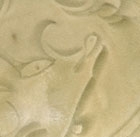J.J. Lally & Co., Oriental Art / New York City, New York
MenuPast Exhibition
The Gordon Collection:
Chinese Ceramics and Works of Art
March 12 - April 4, 2009
6.
A CARVED YAOZHOU CELADON ‘XINIU GAZING AT THE MOON’ BOWL
Jin Dynasty (A.D. 1115-1234)
decorated on the interior with a carved scene of a recumbent horned bovine creature with head raised and gazing up towards a crescent moon and clouds, all enclosed within a quatrefoil medallion surrounded by a double-line petal-shaped frame, with loose scroll motifs in the spandrels, the gently rounded sides left plain on the exterior below a raised band moulded around the rim, covered inside and out with a fine glossy olive-green glaze pooling to a deeper tone in the lines of the carved decoration, the knife-pared edge of the small ring foot left unglazed showing the fine-grained gray stoneware.
Diameter 7 3⁄8 inches (18.8 cm)
A very similar carved Yaozhou bowl in the Palace Museum, Beijing, is illustrated in Gugong Bowuyuan Cang Wenwu Zhenpin Quanji, Liang Song Ciqi, I (The Complete Collection of Treasures of the Palace Museum: Porcelain of the Song Dynasty, I),Vol. 32, Hong Kong, 1996, no. 133, p. 147; and the same bowl is illustrated in the catalogue of the Oriental Ceramic Society exhibition entitled Kiln Sites of Ancient China, London, 1980, no. 446, p. 103, identified as a product of the Huangpu town Yaozhou kilns at Tongchuan, Shaanxi province.
The design of a xiniu gazing at the moon appears for the first time as a decorative motif in the Song dynasty and remains popular through the 13th and 14th centuries on Dingyao and Yaozhou bowls and dishes as well as textiles and elsewhere in the Chinese decorative arts. The theme is discussed at length by Wirgin, Sung Ceramic Designs, B.M.F.E.A., No. 42, Stockholm, 1970, pp. 196-198. According to Wirgin the term hsi-niu meant rhinoceros in ancient Chinese texts, but the rhinoceros became extinct in the post-archaic period, and by the Song dynasty the xiniu had become a beast of legend, known only through literary references. The design of a xiniu gazing at a crescent moon in Song and Yuan ceramics illustrated the popular myth that the unique crescent-shaped horn of the rhinoceros shows the beast magically “communicating with the sky” through its horn. The magical powers attributed to the horn of the rhinoceros in the Song dynasty continued to gain in complexity and popularity in later periods. Supernatural, medicinal and other valuable properties were attributed to the rhinoceros horn by Daoist adepts and medicine men, including the reputation for powerful effects as an aphrodisiac. This led to the production of rhinoceros horn bowls and cups, a category of decorative art unique to China, which flourished in the late Ming and throughout the Qing dynasty.
金 耀州青磁刻花犀牛望月紋碗 徑 18.8 厘米
